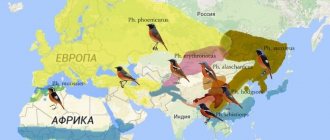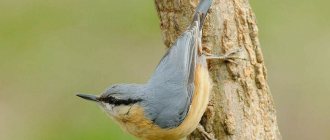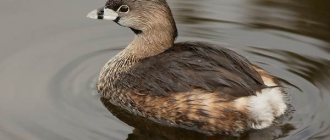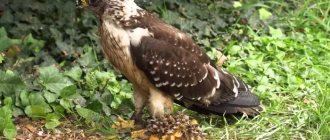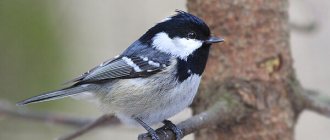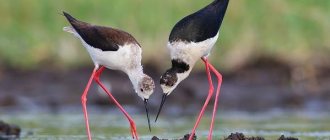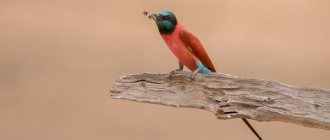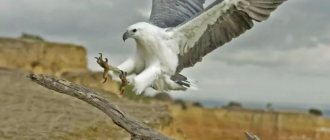| Latin name: | Circus |
| English name: | To be confirmed |
| Kingdom: | Animals |
| Type: | Chordata |
| Class: | Birds |
| Squad: | Accipitridae |
| Family: | Accipitridae |
| Genus: | To be confirmed |
| Body length: | 40-60 cm |
| Wing length: | 36-43 cm |
| Wingspan: | 110—140 cm |
| Weight: | 500-750 g |
Description of the bird
On average, the body length of a harrier is from 40 to 60 cm. The tail and wings of birds of this genus are long, which helps them fly slowly and silently low above the ground. During such a flight, harriers hunt - they look for lizards, chicks, rodents, and frogs on the surface of the earth. The harrier's legs are also long, which is necessary for the bird to grab prey in the grass. On the sides of the harrier's head there is a facial disc similar to that of an owl.
Listen to the voice of the marsh harrier
The harrier soars low from the ground, its flight is smooth and graceful. To catch prey, the marsh harrier can hide in the reeds and then suddenly pounce on the prey. This bird can hunt not only land animals, but even aquatic inhabitants. Flying up to a pond, the harrier instantly grabs the prey and holds it tightly in its tenacious claws.
The victim will not be able to escape from the tenacious claws of the marsh harrier.
The marsh harrier feeds on a wide variety of animals. Among its prey: little owls, frogs, fish, field mice, ground squirrels, wild rabbits, as well as small birds.
Feeding features of the harrier
— Advertising —
The basis of the harrier's diet consists of mouse-like rodents, namely voles, hamsters, and mice. Where there is a lot of such prey, the harrier will feed exclusively on rodents. Thus, in America, Pennsylvania voles become the main prey of the harrier. The harrier hunts, flying low and silently over the surface of the earth, on which the bird carefully looks out for its prey.
Harriers also eat amphibians, reptiles, and insects. They hunt other birds, hares, ground squirrels, and shrews. They rarely feed on carrion.
Is it possible to keep a harrier at home?
The harrier is tamed for hunting, as a bird of prey. The marsh harrier is most suitable for this; it is strong and capable of bringing large game. However, the harrier has a nervous character; it takes a long time to tame and learns slowly.
- The harrier is kept in an outdoor enclosure measuring at least 5 by 5 meters.
- The bottom is lined with dried sphagnum moss or wood cat litter to disinfect and maintain cleanliness.
- They make low perches in the enclosure.
- Place a low container of water inside.
In order for a harrier to become tame and help in hunting, you need to take it from the nest as a barely fledged chick and immediately begin training. If a bird comes to a person as an adult, it is first swaddled and carried in a special bag for several hours a day, and is also fed by hand so that it gets used to the person.
Then they put leather rings on her feet, fasten them with a long strap to her hand in a protective glove, and teach her to fly from hand to perch. After the bird has learned the lesson, they move on to the next thing: they are taught to grab game on command.
What to feed a harrier in captivity
They feed the harrier twice a day with animal food, give them crushed parts of poultry, and buy mice from a pet store. Food is given by hand or placed in a designated place in the enclosure. The bird of prey is given the caught game only to wear; the tamed harrier must receive food from humans.
Look how smoothly the harrier soars over the endless expanse of meadows, as if floating in air waves:
Common types of harrier
Marsh Harrier (Circus aeruginosus)
The bird's body length is from 50 to 60 cm, weight is in the range of 500-750 g, wingspan is from 110 to 140 cm. Females are larger than males.
The plumage of adult males is gray, white, brown or black. The crown is brown or black. The wings are silver-gray. The back and shoulders are black or brown. Females have an ocher head with dark spots, a brown back, and a brown belly with an ocher spot on the chest; the wings are grayish or brown, with streaks. Young birds resemble females in appearance. The iris is yellow, the beak and claws are black, the paws are yellow.
The species' habitat includes the temperate zone of Eurasia, northwestern Africa, the island of Madagascar, and Australia. Northern populations are migratory.
Long-winged Harrier (Circus buffoni)
The plumage on the back of the male is black, the tail is gray, the wings are also gray with wide black stripes. There are white markings on the facial disc. The abdomen can be either white or black. Females generally resemble males in color, but the black color in their plumage is replaced by brown.
The species is distributed in Argentina, Bolivia, Brazil, Guyana, Colombia, Paraguay, Peru, Suriname, Trinidad and Tobago, Uruguay, Chile, French Guiana. Birds live in open spaces of dry savannas, pastures, water meadows, swamps, and forest clearings.
Gray Harrier (Circus cinereus)
Females of this species are larger than males, their body length reaches 46 cm, while that of males does not exceed 40 cm. The wingspan is 90-115 cm. The color of the male plumage is dark gray on the back with black tips of the wings, the rump is white. The abdomen is pale gray with brown streaks. Females are brown on top with a white rump; their belly is beige with streaks.
The species is found from Tierra del Fuego, Argentina, Chile, and all the way to Bolivia, Peru, Paraguay, Uruguay, Ecuador, Brazil, Colombia. The bird is not migratory, but makes small migrations in April and May, from which it returns in early autumn.
Harrier (Circus cyaneus)
The bird's body length is about 47 cm, its wingspan is from 97 to 118 cm. The tail and wings are long. The weight of females is from 390 to 600 g, males are usually smaller in size, their weight is 290-390 g. Sexual dimorphism is also expressed in plumage. The male’s back, throat, crop and “cap” on the head are ash-gray; the tummy, facial disc and rump are white. There is a white spot on the lower back. The dark top and light bottom are clearly separated. A black stripe runs along the rear edge of the wings. The female's back is dark brown with reddish stripes, her belly is light ocher with dark streaks. The underside of the wing has three longitudinal dark stripes. Young birds resemble females in appearance, but they have less streaks and more red in color. The iris is yellow, in young birds it is grayish-brown. Paws are yellow.
The species is distributed in the northern hemisphere from the forest-tundra of the north to the steppe zone of southern Eurasia. In addition to the mainland, the bird is found on the British, Orkney, Hebrides, Shantar Islands, and Sakhalin. The Hen Harrier also lives in North America.
All populations are migratory.
Steppe Harrier (Circus macrourus)
The back of males is light gray with dark shoulders, eyebrows and cheeks are white. The belly is light gray. The wings are gray above with a white border, white below. The rump is light, the tail is gray with a white border. The beak is black, the iris and legs are yellow. Females are brown above with a mottled head, and the tips of their wings are rufous. The forehead, eyebrows and spots under the eyes are white. Cheeks dark brown. The wings are gray. The rump is white. The tail is brown. The undertail is reddish or rufous. The legs are yellow, the iris is brown.
The bird lives in the south of Eastern Europe and Central Asia. For the winter it goes to India and southeast Asia.
Piebald Harrier (Circus melanoleucos)
The bird's body length is from 43.5 to 52.5 cm, weight is 310-550 g, wingspan is from 105 to 115 cm. Females are larger in size than males. Males have black plumage on the head, back and middle of the wing, part of the wings and rump are white, the belly is light, the throat and breast are black. Females are dark brown on top and have a whitish belly. Young birds are dark brown above, with a buffy-reddish rump and a brownish-red belly. The iris in adults is yellow, in juveniles it is brown. The beak and claws are black, the legs are yellow.
The piebald harrier is common in eastern Asia: in Northern China, Mongolia, and in Russia from Transbaikalia to the Amur region. Migratory species. Spends the winter in southern Asia.
Meadow Harrier (Circus pygargus)
The smallest species of harriers with a body length of 41 to 52 cm, a wingspan of 97 - 120 cm. The weight of males is 227 - 305 g, females are larger and weigh from 319 to 445 g. The plumage of the head, back and wings of the male is ash-gray. . The head, throat and chest are pale gray. The belly and undertail are white with brown spots. The wings are dark above and light below with bright stripes. Transverse stripes are also visible on the tail. The female's back is grayish-brown, her belly is buffy. The species differs from related species by a white spot on the lower back. Young birds are dark brown, similar to females. The beak is black. Rainbow is yellow.
The species is distributed in northeast Africa (Morocco, Algeria) and in Eurasia from the western coast of the Atlantic to the Altai Mountains.
Lifestyle and habitat
In winter, the swamps freeze, small birds and waterfowl move south. This is probably why the marsh harrier is bird . The eastern population winters in Hindustan. Birds that nest in northern and temperate European latitudes migrate to the African tropics. Marsh harriers from Western and Southern Europe fly to Southeast Africa, in the region of Zambia and Mozambique.
In Spain, Turkey, and the Maghreb countries there are populations living sedentary. Their range is adjacent to the Mediterranean Sea. Living conditions and climate allow these birds to abandon seasonal migration. The number of sedentary birds is not large, does not exceed 1% of the total number of all marsh (reed) harriers.
Migration to wintering begins in the fall, in September-October. Done alone. Hawkbirds in general, and marsh harriers in particular, do not form flocks. The only social group that Loonies create is a couple. There are precedents when the union of a male and a female lasts for several years. But usually the couple interacts only for one season.
In nesting and wintering areas, harriers choose terrain of a similar type. They prefer swampy, flooded, waterlogged meadows. These are often agricultural fields adjacent to swamps or shallow lakes. Harriers fully live up to one of their names: they are partial to reed thickets.
Male and female harrier: main differences
The first sign of sexual dimorphism for the harrier is that females are always larger than males. As for plumage color, differences between the sexes depend on the species. As a rule, males have more contrasting plumage, with a dark top and light bottom, while in females brown tones, red, and mottled predominate.
What birds are similar to the harrier?
The harrier bird is a representative of the falcon family! This species of feathered predator has several brothers. There are also birds similar in description to the bright representatives of harriers.
Eagle - burial ground
Large bird of prey of the hawk family. It chooses steppe and forest-steppe as its habitat. It has similar habits to the harrier and a characteristic color.
Photo of Imperial Eagle
Snake eater
Another representative of this family. The large feathered predator is similar to the harrier in color, size, and some habits. However, this bird has completely different gastronomic preferences, which are easy to guess from the name.
Photo of the snake eagle bird
Steppe kestrel
From a distance it is easy to confuse it with the steppe harrier. However, upon closer examination it is clear that the similarity can be traced only in color, size and, more distantly, in body structure. The kestrel has a neater beak. The bird belongs to the same hawk family. However, it looks less like a predator than its previous relatives on the list.
If you look at a photo of a marsh harrier or another type of bird, it is easy to conclude that almost every member of the family is similar. But, each species and breed has its own differences, which are not limited to external qualities, but also extend to character, habits, and habitat.
Photo of the steppe kestrel
Harrier breeding
Harriers reach sexual maturity at the age of 1 year. Most birds are monogamous. While courting the female, the male performs real acrobatic stunts in the sky: first he flies high and then falls sharply down, spinning.
Harriers nest in small colonies, from 15 to 20 pairs. During the mating season, the harrier guards its territory very carefully, drives away birds from the nest and even attacks humans.
Harrier nests are often built directly on the ground, in clearings near water and large open spaces, such as fields, meadows, and swamps, where the birds hunt. The harrier's nest is a flat structure made of dry thin branches, lined with grass stems on the inside. The diameter of the nest is from 50 to 60 cm, the height is 25-30 cm. The nest is mainly built by the female, while the male hunts.
The harrier has one clutch, which occurs in mid-May or early June. The clutch contains from 3 to 7 (usually 3-5) white eggs with a blue tint. The female does the incubation. Only occasionally does she leave the nest to the male. Hatching lasts about 32 days. The chicks are born in white down with a grayish-ocher tint. The male is engaged in obtaining food, and the female feeds the offspring. After two weeks, the male leaves the nest, and the female continues to care for the offspring. The chicks leave the nest at the age of 1 month.
Lifestyle
Harrier is a migratory bird. However, in Spain or Turkey you can find populations that live sedentary. Thanks to good living conditions, they refuse to migrate.
The journey to wintering areas starts in the autumn; they usually do not gather in flocks for this. The only alliance they have formed is a couple. And then she doesn’t exist for more than one season.
To create a nest and wintering period, birds tend to choose similar terrain. So, these are flooded meadows or fields created for agricultural needs. They got their name precisely because of their love for reed thickets.
Interesting facts about the bird
- The plumage of some species of harriers is bluish-ash-gray, and from a distance in flight it appears whitish. A white-headed, gray-haired person is often compared to such a bird, when they say “gray-haired, like a harrier.” In addition, the bird's curved beak and crown of feathers around the cheeks and chin are very reminiscent of a bearded, gray-haired old man. There is also a version that this saying is associated with a change in the color of males during maturation, as young birds turn from brown to “gray-haired”.
Conservation status of the population
Due to their wide distribution, harriers are generally not considered vulnerable. The International Union for Conservation of Nature has classified most species as Least Concern. However, it should be noted:
- The Reunion marsh harrier and the Madagascar marsh harrier are listed as endangered in the international Red Book due to their low numbers. The black harrier species is considered close to extinction.
- The gray harrier is decreasing in number due to shooting and drainage of swamps.
- The Steppe Harrier is listed as "near vulnerable." Pollution of arable land with chemicals and cultivation of natural steppes and forest-steppes reduce the number of this species.
- Due to poor nutrition at the end of wintering, the meadow harrier reduces its population.
THIS IS INTERESTING . The meadow harrier wintering in Africa has plenty of food. But when it's time to fly home, the dry season sets in and food becomes scarcer. Birds need to accumulate strength and they are forced to “play for time.” The dates for returning home are being pushed back. As a result, parents feed the chicks closer to autumn, when food is scarce. The chicks do not have time to grow stronger and die.
Enemies of the harrier in nature
In nature, other predators do not specifically hunt the harrier; it is a predator itself and stands at the top of the food chain. An adult bird can only be threatened by a goshawk. He is known for his rage and when very hungry, he grabs any bird indiscriminately.
But humans pose a much greater danger to the harrier. Hunters, for example, shoot the marsh harrier, considering it a harmful bird because it destroys the nests of waterfowl game birds. In the Krasnodar and Stavropol territories in the 50s of the last century, the steppe harrier disappeared completely: chemicals against rodents were massively used in the fields and the harrier was completely deprived of the main subject of hunting. Many nests of hen harriers are destroyed in the summer during haymaking.
Where does the steppe harrier live?
Photo: Steppe harrier bird
As sad as it sounds, the harrier predator today is one of the endangered species of birds, which has become increasingly rare.
The steppe harrier loves:
- the steppes of southeastern Europe, and in western Europe its range reaches Dobrudzha and Belarus;
- space of Asia, settling to the territory of Dzungaria and Altai Territory;
- southwest Transbaikalia;
- the northern zone of our country, where the settlement area is limited to Moscow, Tula and Ryazan, as well as Kazan and Kirov;
- Siberia, Arkhangelsk, Krasnoyarsk, Omsk and Tyumen regions (found in summer);
- southern Crimean and Caucasian expanses, Turkestan and Iran.
It is in the south that the bird population is most numerous. But in Germany, Sweden, the Baltic states and in the north-west of Mongolia there are very few harriers, but they still occur. Very rarely, the steppe harrier has been seen in Britain. Do not forget that the harrier is a migratory bird that moves to new places due to insufficient food or uncomfortable climatic conditions. There are also sedentary birds, which mainly inhabit the Crimean steppes and the Caucasus.
Interesting fact: To spend the winter, the steppe harrier goes to the territories of Burma, India, Mesopotamia, and Iran. The predator flies to both the African continent and the north-west of the Caucasus.
From the name of the bird it is clear that this harrier loves steppes, open plains, wastelands, and also settles in wetlands. Uncommon, but sometimes found in open forest areas. A predator needs sufficient visibility from above in order to successfully hunt, looking down on its potential prey.
Now you know where the steppe harrier bird lives. Let's see who he's hunting.
Nesting and offspring
Only the female is involved in the construction of the nest. She incubates the clutch. Nesting takes place below, in last year’s dry, coarsened grass, among tall growth. A marsh, steppe bird or meadow harrier will always choose an open area of terrain for nesting. The nest can be represented by neatly twisted branches with grass or an ordinary depression in the ground. Chick incubation time is 28-38 days. During this time, the female does not leave the nest and strictly guards the area around the home. The male brings food to the female. Seeing a male flying in the distance, the female quickly flies out of the nest and, simulating an air fight, takes food from the beak of the “faithful”. This theatrical performance is necessary for intimidation, so that not a single living creature would want to get closer to the laying site, and subsequently to the hatched chicks.
Marsh Harrier Nest
Social structure and reproduction
Photo: Steppe Harrier in Russia
Steppe harriers become sexually mature when they are closer to three years of age. The wedding season for birds starts in the spring. At this time, you can see the aerial tricks of the males, impressing the winged ladies. Predators soar into the sky with lightning speed, and then sharply dive down, performing somersaults and flips right on the fly. At the same time, loud exclamations are heard. Females can also dance together with their gentlemen, but their range of tricks is not so expressive and fast-paced.
Ground nesting sites are quite simple; they are small depressions lined with dry, coarse grass and shrub branches. Inside there may be a bedding of softer blades of grass. Eggs are laid in April or May, and there can be from three to six eggs in a clutch. The predominant tone of the shell is white, but specks of a brownish hue may be scattered on it. The incubation period lasts from 30 to 35 days; expectant mothers hatch the cubs.
Interesting fact: During hatching and raising their offspring, harriers become extremely aggressive, zealously protecting their offspring. They do not retreat from any danger; they can easily drive away even a fox, a dog and an eagle.
Chicks may hatch in late June or early July. The entire brood stays together until August. The female and newborn babies are fed by a caring father and partner; after some time, the feathered mother flies out of the nest and hunts independently. In very small chicks, the body is covered with white fluff, then it becomes pale cream, gradually acquiring a more pronounced brownish tint.
The chicks do not leave their nesting site for 35 to 48 days, after which time they begin to make their first inept flights, preparing to fly to warm countries. The end of the reproductive age of harriers occurs closer to eighteen years of age, and they live in the natural environment from 20 to 22 years; in captivity they can live for a quarter of a century.
Appearance and features
Photo: What a steppe harrier looks like
It is very easy to distinguish a female steppe harrier from a male if you know all the nuances in the coloration of the birds. A mature male has a light bluish coloration, and its lower part is almost white. The steppe harrier has lighter tones of plumage than its field brother. On the tops of the bird's wings, a wedge-shaped spot is immediately noticeable, which does not cover the flight feathers. The light belly has the same whitish coloring as the head, crop, and neck.
The color of the female is brownish-variegated, the wings and tail are lined with stripes, and in the area of the upper tail there is a narrow crescent-shaped spot of white. The tail has four on top and three wide stripes located transversely on the bottom. Of all these stripes, only one is clearly visible - the apical one. The female's eye is bordered by a dark bracket, over which there is also a light border. From a distance, the female steppe harrier is very similar to the female meadow harrier; it is impossible for the average person to tell them apart.
The young birds have an ocher-red color, the tone of which is lighter compared to young meadow harriers. The front part of the head of the steppe harrier is outlined by a kind of light-colored collar. The bottom of the wings is lined with stripes. The legs of young birds, like those of mature birds, are yellow. The eyes of young animals are dark in color, and with age they become yellow or light brown.
Like all other hawks, the steppe harrier has a hook-shaped black beak. The feathered paws are quite powerful and are dressed in feather trousers from the top to the knees. Compared to other hawks, whose physique is quite dense and stocky, the steppe harrier has a very slender figure. Its distinctive feature is the presence of narrow wings. When the steppe harrier flies high, it somewhat resembles a seagull. The flight of these birds is always energetic and swift, the flapping of their wings is very frequent. During a gliding flight, the angle between the raised bird wings can vary from 90 to 100 degrees.
